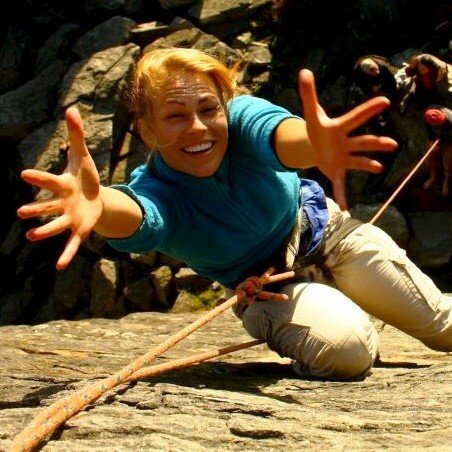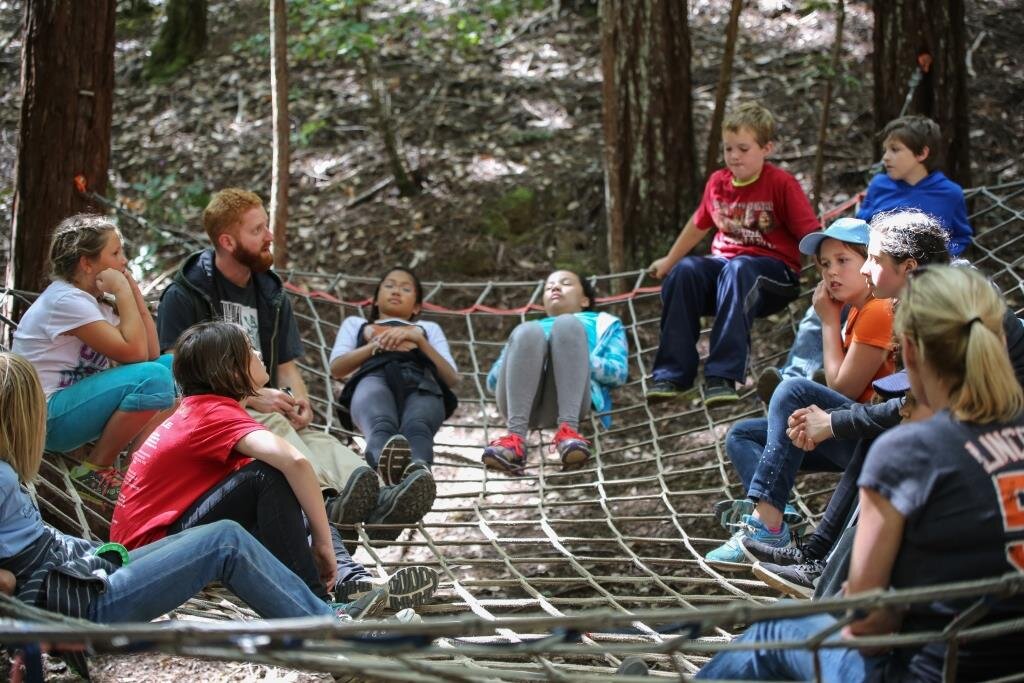Social Emotional Learning (SEL) has become an important topic in education over the past few years. Last week, I sat down with our School Programs Director, Kori Donley, and our Challenge Course Manager, Jessica Barry, who both have extensive knowledge about the subject. Read our conversation below to learn about SEL and why we teach it at the Woods.
Kori is part of the Residential Environmental Education Partnership (REEP), a partnership between 11 organizations across the country that is working to develop a framework for Social Emotional Learning for residential environmental education programs. She will be presenting about REEP at the statewide Manager's Retreat for the Association for Environmental and Outdoor Education (AEOE).
Jessica is a certified Challenge Course Manager and Social Emotional Intelligence Trainer. Through her Human Accelerated Performance (HAP) certification, Jessica is trained in both Social Emotional Learning (SEL) skills and how to teach SEL skills to other people.
What is Social Emotional Learning and why is it important?
Jessica: The way I’ve been trying to sum it up for people is, Social Emotional Learning is the process of getting to know yourself, getting to know your community, and getting to know your environment and how those things relate. This is important because it is literally what everyone is doing at all times; people have been relating to each other and their environments the entire time humans have been around. What’s exciting is that now we have enough knowledge about psychology and physiology that we are starting to develop better tools to guide how we could relate to each other.
Kori: I totally agree. There’s a lot of research that shows that these social and emotional skills can profoundly impact a student’s success in life, their sense of efficacy, and their perceived happiness. These skills are on par with academics, which is really powerful. The most amazing part is that these skills can be learned! For example, if someone’s a good communicator, it’s because they are practicing that skill and putting effort in daily to improve their communication practices. It’s not an innate skill. That’s the best news, because it means we can all become the people that we want to be.
How do we teach Social Emotional Learning at Westminster Woods?
Jessica: We have this new language that we are calling ‘Social Emotional Learning,’ but the activities, tools, and reflection on our interactions with people have always been built into the activities we run on the challenge course. We have been doing Social Emotional Learning the entire time, whether it’s learning how to communicate and trust each other, how to find strength and bravery within yourself, or learning how to ask for the support you need; all of this is built into our activities. As an educational institution, we are always seeking to learn, so it’s exciting to witness the momentum behind this movement across all sectors of education. There are studies, tools, and shared language to take our game even further. So it’s like, yes, let’s do this together now!
Kori: Absolutely, that’s well said. It’s amazing that we have this built into our program already, and now with the excitement about Social Emotional Learning we have more buy in and more support from schools. The framework we use is CASEL, Collaborative for Academic and Social Emotional Learning, which includes five core competencies: Self-Awareness, Self-Management, Social Awareness, Relationship Skills, and Responsible Decision Making. Social Emotional Learning is becoming more ubiquitous across the country, so when students come to the Woods, they already have language attached to these skills. There are more opportunities for students to practice SEL, because of the potential support from their outdoor experience to school and back to their homes.
I agree that this is something we have been doing; Social Emotional Learning happens all the time, whether it’s positive or not. So with more people on board, we can be more intentional about building skills from the beginning to the end of our program. For example, spending time away from home with teachers and peers has learning opportunities embedded throughout. We are checking in with students about cabin life, dining hall dynamics, or issues that arise during free time. These are opportunities for us to offer students support by connecting learning from our facilitated programs to navigating camp life. This helps students to reflect on the embedded opportunities for social emotional learning rather than limiting learning to class time.
Furthermore, teaching science with the Next Generation Science Standards gives us the perfect laboratory to apply these skills. Our science education asks students to collaborate with their peers, communicate their results, and form statements grounded in evidence. These are skills that support people’s relationships to each other, and so in addition to the residential setting, we’re now practicing SEL on our hikes and in the labs. Every place is an opportunity to learn these skills.
What is something you’ve learned about emotional intelligence that you wish you had been taught at an earlier age?
Kori: I wish I knew the piece about these skills being learnable rather than innate. I definitely had the perception when I was younger that if she was good with people, she’s just outgoing and charismatic; I felt like I couldn’t be that person. I still want people to be true to themselves—that’s at the heart of any skill we’re building—but we can specifically practice skills that help us better connect with others. I certainly wished at some points that I had different skills, and it wasn’t until I was older that I realized, I can take steps to practice this consistently, and I will get better.
Jessica: I would say similarly for me, wishing that I had had skills or tools at a younger age to help navigate social interaction of all kinds and understand that it’s okay to be human, and it’s okay to interact in different ways. Even things like learning how our brain works: how to not have knee-jerk reactions about things and think a little more analytically about things. An easy way to get into your executive brain is to be asked questions or ask someone questions to help them get there, and we utilize that a lot on the challenge course to bring participants out of their fear-based reactions. I’m already using it with my two year old daughter. We have a flip book of emojis that show the different emotions, and we talk about that. So she already has a whole list of emotions that she can say and name and talk about.
Kori: I do feel like in the past I was expected to go figure it out.
Jessica: Or things that were happening were just swept under the rug.
Kori: Right. And there are so many areas in our society right now where we are drawing attention to equity for all people. We are having conversations which were avoided in the past. So now to address inequity, our hope is to have conversations, listen to both sides, and try to problem solve rather than just leave it to kids who may or may not have the skills to navigate those situations. We can offer support in a structured way that respects all people involved but also addresses any problems that are happening here on program and reflecting back on what’s happening in home life.
How does the work we do here transfer back into students’ lives at home and in their classrooms?
Kori: I think for one thing, with the CASEL framework, we have a tool which provides us shared vocabulary. With the five defined core competencies, there are concrete skills for students to practice and develop. If they’ve been introduced to that at school, we can carry those goals through our program. If they’re introduced here, great, we involve chaperones and teachers in every group, so they’re hearing the vocabulary, seeing our debrief tools and how we ask students to reflect. There is always a transference piece at the end of the week. And that’s: “What did you learn?” and “So what does that mean for you?” We’re not telling students what that means in their lives; we are asking them how it applies to their school life, home life, and how they will continue to build these skills after they leave here.
Jessica: Yes, I even communicate that directly to the chaperones. We are going to practice social and emotional skill building and here’s what it looks like. We are going to reflect on the interactions we have, but this doesn’t stop here. We hope the discussion and reflection happens in the classroom and back home. Sometimes the difference is giving teachers and parents some tools and language to use if they haven’t heard it before. The most impactful thing we can do is model behavior for the students and chaperones, so they can learn from example.
What are some resources for folks reading this blog if they want to work on their own Social Emotional Learning?
Jessica: Some advice for continuing that work beyond their time here is to look into it, get educated about it. There are a lot of resources out there. But also know, to use one of our terms, it’s okay to be “raggedy” with it. And it’s okay to be a human and be figuring this stuff out because nobody’s an expert at life, and we are all figuring this out together. Find confidence with that knowledge of interacting with other humans in ways that’s not just happy and smiling. A lot of people shy away from that, adults especially. They want to be liked, more than they want to be consistent upholding boundaries, and so it takes some reflection on your own behavior and some bravery to decide to really look at what’s happening and how you might improve. We have the knowledge. We have the tools. We have the language. The next step is for people to step up and look into it themselves.
Kori: I want to build on your point of how we model behavior. We’re good at modeling, but it’s not because we are born that way: it is not innate. We are good because we practice.
Jessica: We are immersed in it.
Kori: Yes. And I love the honesty of saying we don’t nail it one hundred percent of the time. No way! But we really are intentionally practicing with each other, and we give feedback consistently, and this whole process has to be internally motivated. Even if someone is reading this blog thinking, “Oh I wish my students had better social emotional skills,” I recommend starting with you. Reflect on how you are modeling learning and practicing the skills. What is the work you are doing? There is no “life hack” for being good at Social Emotional Learning. You don’t just “be good.” And you don’t just help your students “be good.” This is a practice, and that’s what we can support: we hope it is ongoing from school to home to our program.
What is a key takeaway point you would like readers to consider?
Kori: Social Emotional Learning supports equity in a way that we haven’t seen before. And with that conversation coming to the forefront of the national mind, even internationally, we’re seeing that equity and inclusion are vital. It’s not enough to be multicultural or diverse; we are looking for more equitable access to everything, so if we are going to break out of our silos and be united, we need to listen and have conversations with each other. And so this is at the heart of Social Emotional Learning: building the skills to work with and connect with everyone, regardless of who they are. I believe in the tools because the impact is vital.







